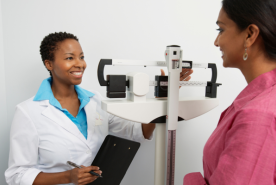August 12, 2014
Everyone needs blood pressure to help circulate blood to vital organs, but how much is enough? And how much is too much?
High blood pressure, also known as hypertension, is often called the "silent killer" because it usually doesn't cause symptoms. It increases the risk of heart disease, kidney disease, and stroke. Doctors have long known that very high blood pressure can be dangerous, but even slightly elevated blood pressure should be taken seriously.
How Blood Pressure Is Measured
When you visit your doctor for an annual checkup, your blood pressure will be taken using a cuff wrapped around your arm. The measurement indicates whether your blood pressure is normal, low, high, or somewhere in between.
- High blood pressure is defined as readings above 140/90 over time.
- Prehypertension is a systolic reading of 120–139 or a diastolic reading of 80–89.
If your numbers fall into the "prehypertension" range—higher than normal but not quite high enough for a hypertension diagnosis—it’s a warning sign of potential future health problems.
Subscribe today!
Join the NKF Blog Newsletter
Get inspirational stories and kidney disease resources delivered to your inbox every month. You'll gain practical insights and expert advice to help you better understand and manage your kidney health no matter where you are on your kidney journey.
Rising Blood Pressure in America
Blood pressure is a growing concern in the United States. According to the CDC, nearly half of all American adults, around 119.9 million, have high blood pressure. Risk factors include a family history of hypertension, being overweight, eating a high-sodium diet, and kidney dysfunction.
The link between kidney function and blood pressure goes both ways:
- High blood pressure can cause kidney disease.
- Kidney disease can cause high blood pressure.
In fact, slightly elevated blood pressure sustained over time can harm the kidneys, which produce a hormone that regulates blood pressure.
Reducing Your Risk
The good news? You can take steps to reduce your risk of heart disease, kidney disease, and hypertension:
- Follow your doctor's advice and take all prescribed medications.
- Make lifestyle changes, like losing weight, eating healthier, and getting more physical activity.
- Stop smoking, as it significantly raises your risk of heart and kidney problems.
Heart disease is the leading cause of death worldwide. Even if you feel healthy, slightly elevated blood pressure increases your risk. That’s why blood pressure is called the "silent killer."
Taking Control of Your Blood Pressure
Here are practical ways to help manage or lower your blood pressure:
- Maintain a healthy weight.
- Be physically active.
- Limit alcohol consumption.
- Eat a heart-healthy diet with less salt and fat, like the Dash Diet.
Ask a healthcare provider or kidney dietitian if the Dash Diet is right for you
The Dietary Approaches to Stop Hypertension (DASH) plan can help lower blood pressure. It emphasizes:
- Fruits, vegetables, and whole grains
- Low-fat or fat-free dairy products
- Lean proteins like fish and poultry
Learn more ways to reduce sodium (salt) intake.
By making these changes, you can take control of your blood pressure and protect your kidneys. Talk to your doctor today to learn more about your personal health risks and how to manage them.
*This content is provided for informational use only and is not intended as medical advice or as a substitute for the medical advice of a healthcare professional.


















